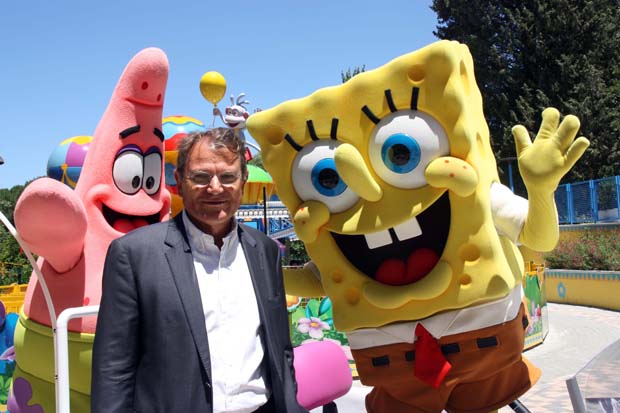Yann Caillère joined Europe’s second largest amusement park and attractions operator as its new CEO at the start of 2014. Here he speaks exclusively to Park World.
Parques Reunidos is the second largest operator of leisure parks in Europe, with 70 theme parks, amusement parks, waterparks, animal parks, zoos, aquariums and other family attractions in 12 countries including Spain, Belgium, Norway, Denmark, France, Italy, Germany, Holland, the UK and Argentina. Its US operation, Palace Entertainment, currently runs 38 parks across North America. A French citizen born in Morocco, Yann Caillère brings with him a successful track record as an executive in the hospitality and leisure sector, serving as CEO of both the Accor and Louvre hotels group, and as a former chief operating officer of Euro Disney. He is married with one daughter and one son.
What was the previous management team’s legacy at Parques Reunidos?
What I see is that team did a great job over the past 10 years in mergers and acquisitions. Originally Parques Reunidos was just a Spanish company, but they expanded step by step in Europe, and in the US too. I think Richard [Golding] did a great job in this direction.
What goals did you set yourself when you started as CEO?
I wanted to make a plan for three weeks, three months and three years. Three weeks was the time I thought I would need to get a sense of what was really going on with the business, understand the figures, visit some parks etc. We screened all our parks with a SWOT analysis. Three months was the time needed with the team in order to develop a strategy and make sure everyone was on board. And three years is how long we have to implement it.
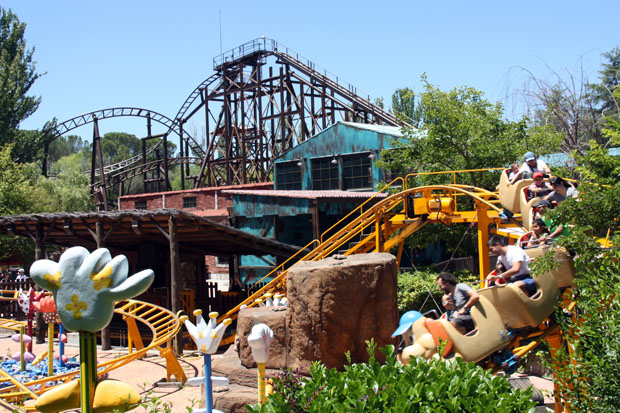
Parc de Atracciones Madrid
What does your strategy include?
There are two priorities. The first is to optimise the portfolio or parks by focusing more on the customer experience and leveraging our existing assets. We need to raise our EBITDA, and we need to gain two million more visitors because the last years we have lost visitors. We are working on a revenue management strategy for all of the parks, and we plans to do more with digital, such as apps and online booking.
Optimising assets also means making some capital expenditure, creating new experiences as we have done this season with Nickelodeon Land at Parque de Atracciones (Madrid), Dinoland at Mirabilandia (Italy), the Lost Temple at Movie Park (Germany) and the Smurfs at Bobbejaaland (Belgium). We need to be more storytellers; not just a collection of rides. This is what we are doing to raise the bar in terms of quality and guest satisfaction.
The second priority is expansion, either full acquisitions as we have just done with the Seaquarium in Miami, or management contracts. For example, we have struck deals to manage two new parks in Dubai, which are scheduled to open at the end of 2016/ beginning of 2017 [details on page 20 – Ed]. And if there are some parks that are not key to our strategic goals, then maybe we will look to sell them.
In addition to Dubai, where else in the world do you believe has potential for international expansion?
Dubai is a booming region with 150-200 hotels coming in the next five to six years. It is doing well because it has a double offer – business and leisure. Sometimes the hotels are attractions in their own right, but all of the people coming to those hotels are potential customers for the parks we will be involved with. Oman is also an interesting proposition, very different from Dubai because it is very much a green destination with no high buildings, but they have turtles, dolphins and other tourist attractions, and they have money too.
Then there are some regions we are not present in for the time being. North Africa has potential for sure. In Morocco for example, you could have a big theme park in Casablanca or a waterpark in Agadir or Marrakech. There is money in Algeria. Egypt could be a destination if they stabilise the political situation. I believe very much in the rest of the Africa, but so far most of the time it is one country, one city.
I would say there are three or four regions in Asia-Pacific. You have Australia, where there are already some parks and to enter the market with a new product would be difficult. You have China, which by itself it is a market. It is possible to enter the country if you have a good partner, By ourselves, forget it, the learning curve would be too painful. Then you have eastern Asia – Vietnam, Thailand and Indonesia, which is a country with true potential.
In South America we already have an aquarium in Argentina, where they are good at soccer but it is a tough economy. However, this part of the world is growing. You have the two big countries, Mexico and Brazil, but you also have a few smaller countries with potential, such as Chile. For us as a Spanish company, Latin America is a natural destination because the language, the culture, it is easy for us.
We will go step by step, pushing into new regions just as soon as we can. We cannot go too fast because of our owner, the equity fund. You know the story, usually they do not plan to spend their whole life with you.

Mirabilandia, is a flagship property for Parques Reunidos in Italy
What is the outlook for Europe?
We see some signs of recovery in Spain, where I hope the VAT rate will not increase one more time as we see in France. In Italy we start to see some recovery, but it is a slow increase. We don’t have so many operations in the UK but those we have, like Blackpool Zoo, are doing well. In Germany the economy is good; that is one reason we invested this season at Movie Park. Elsewhere in Europe we still have room to develop, in Eastern countries like Russia, Hungary and all the “stans” (Kazakhstan, Turkmenistan, Uzbekistan etc) and probably Turkey. Turkey has high potential; they are ready.
How big is your “war chest”?
Between the renovation cap ex and acquisition cap ex we basically have €200 million to spend over the next three years. Of course it is a significant amount, and it gives us a lot of potential, but we are not a huge company like Walt Disney. We are an average-sized company, and we must not miss our focus. If some measured opportunities arose that were outside our plan then we would go back to the board, but I would not make an acquisition for the sake of acquisition; maybe at one time this is something we did.
Why does the Miami Seaquarium acquisition make strategic sense?
First of all the attendance (650,000), revenue and EBITDA provide a good starting point. Number two, we know marine animals very well, we are not taking risks. Then there is the fact that Miami is a true hub between the US, South America and Europe; the visitors come from everywhere. Also it’s a year-round operation with the weather. Miami will always be Miami!
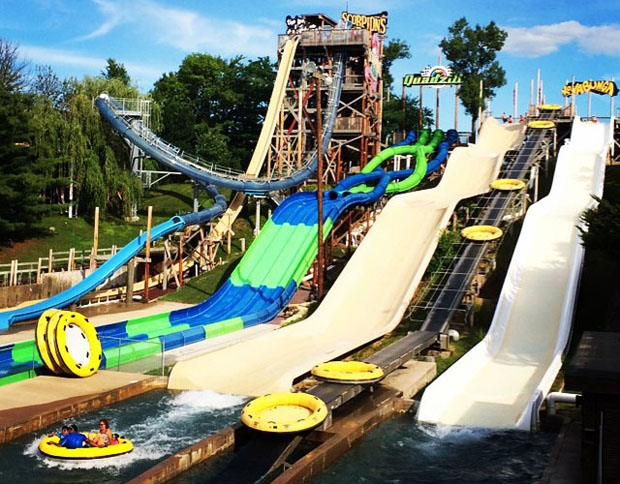
Noah’s Ark waterapark is part of the Palace Entertainment portfolio in the USA
Would you consider building any new parks from scratch?
No. It is not only a matter of money, it is a matter of time. It takes six years to develop a hotel; you can easily add two more years to build a park. From what I see in the history of this company we are very good at making acquisitions and improving the performance of existing parks. The Dubai parks are new projects, and we will advise the owner in terms of designing the park, selecting attractions, pre-opening etc, but when it comes to building a park in the middle of, I don’t know where, no we will not do that.
Parques Reunidos has allowed the attractions it has acquired to keep their original names and identities, even allowing your US facilities to continue to operate under the umbrella of Palace Entertainment. Why is this?
That was one of the questions I asked when I joined the company, because it would be much easier when you are on the web with one name for all our parks, but the amusement park business is different to the hotel business. Don’t forget there were some who tried and failed in Europe. You remember Six Flags taking over Walibi, it was a total failure. Most of our parks are very original. When you go to Tusenfryd in Oslo, Bobbejaanland in Belgium or Slagharen in the Netherlands, to the local people it is their park. It’s the same in the US; they don’t know that Kennywood is part of Palace Entertainment, which is run by a Spanish company owned by a British fund – and they don’t care. The true customer when he goes to Kennywood he wants to have nice rides, a very specific kind of atmosphere and a burger with bacon and cheese. And this is what we give them.
We have looked across the portfolio to see if there is any brand we can exploit, and I think there are a few brands we could roll out internationally, but only for specific parks. Obviously we are already working with some international brands, like Warner at Parque Warner Madrid. What I am pressing on with is the presence of IPs in our parks. Families might not care that Parques Reunidos owns the park, but they are interested in the opportunity to meet SpongeBob, the Smurfs, Bugs Bunny or whatever.
It is now some years since Parques Reunidos took over the running of Parque Warner, a former rival to your many other attractions in Madrid. What lessons were learned as it was integrated into the group?
To be fair, I think the park [launched by Six Flags as Warner Bros Movie World in 2002] did not open at the best period of time. I think they probably approached this park in a too American way. I suppose in some ways it’s the same as Disneyland Paris, which when I joined [in the mid-90s] was very much a US-style organisation with a lot of backstage people. Basically we have adapted the product at Parque Warner to make it fit into our organisation by making it more efficient and delegating more power to the operator instead of having people making hundreds of reports and conference calls. At the end of the day what matters is the guest experience.
Would it make sense to reintroduce the Warner Bros name at Movie Park in Germany?
I think it is doing well without it! When you enter into this kind of [licensing] agreement, you know how much it is going to cost you, but you don’t know how much it is going to bring you in return. So for the time being Movie Park will continue with its own positioning. I think if we do anything, it will be reinforcing the quality of the destination and the new attractions we are adding like the Lost Temple, alongside the Nickelodeon IPs and some very nice projects like Halloween, which is very successful for the park.
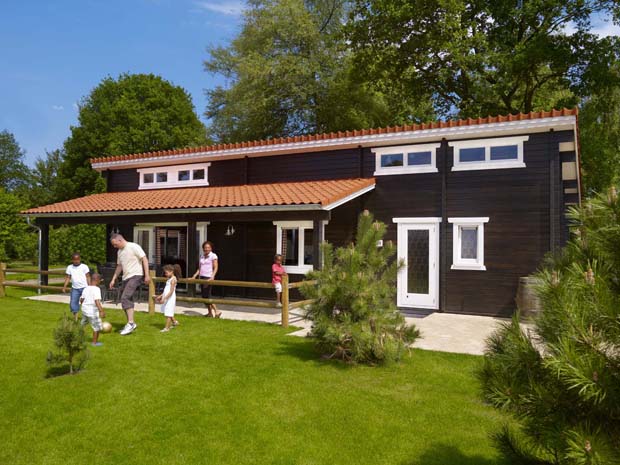
Slagharen in the Netherlands already boasts on-site accommodation
You recently announced a €50 million expansion for Marineland in France, including a hotel and other facilities. What other parks within the group have potential to be developed into “resort” style operations?
I think I would say some parks have potential as destinations, because a resort to me means somewhere with a beach by the sea, not just adding a hotel. Parque Warner could be a destination park, because the park is huge and we have just launched a nice family waterpark, Warner Beach. So this could be the kind of park that would logically make sense for lodging facilities.
We have Slagharen in the Netherlands, where you already have a lot of lodging, we can accommodate up to 3,000 people. Maybe Mirabilandia too, because it is a big park with good attendance very close to a vacation destination [the Italian Riveria], so that could have potential too.
Are you happy staying at the number two position in Europe (and number six worldwide) or have you set your sights higher?
Of course we want be to be up there. We were the number four operator in the world rankings, but because of the newer Chinese players and because we decreased our attendance in 2013 we are currently number six. I am not obsessed about being number four, five or six, because when you see the difference you are talking about 250,000 visitors. That’s nothing, three big weekends and you make up the difference. What is important is our EBITDA, that we are profitable, are doing well at our job, and that the guest satisfaction is high. Then it’s a matter of how and where we grow. That is what’s important, the rest will follow.
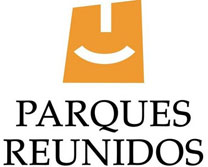
70 parks and 26 million guests
Of Parques Reunidos’ 70 global properties, 14 are owned outright by the company, the remainder either operated under a lease agreement or management contract with their respective owners. In total, the group entertained 26.2 million guests in 2013. Group revenue last year was €540 million, delivering EBITDA (earnings before interest, tax, depreciation and amortization) of €167 million. Backed by the British private equity fund Arle Capital Partners, the company is headquartered in Madrid, within the grounds of Parques de Atracciones.

